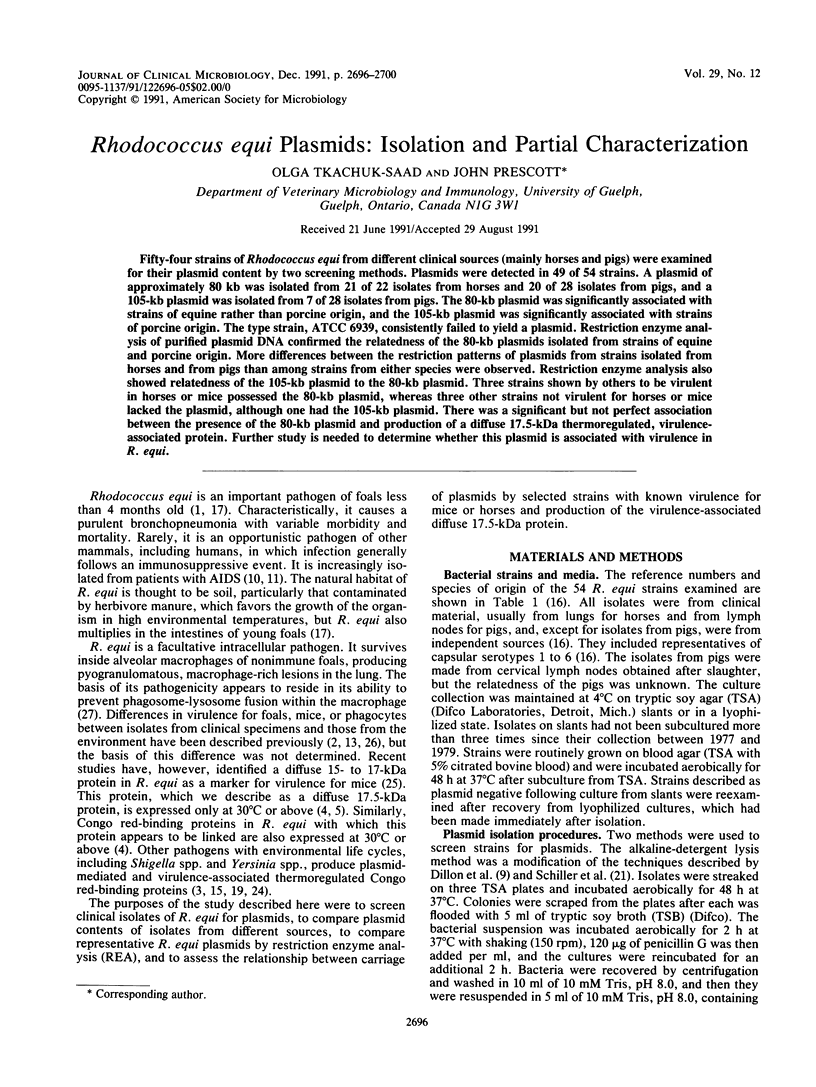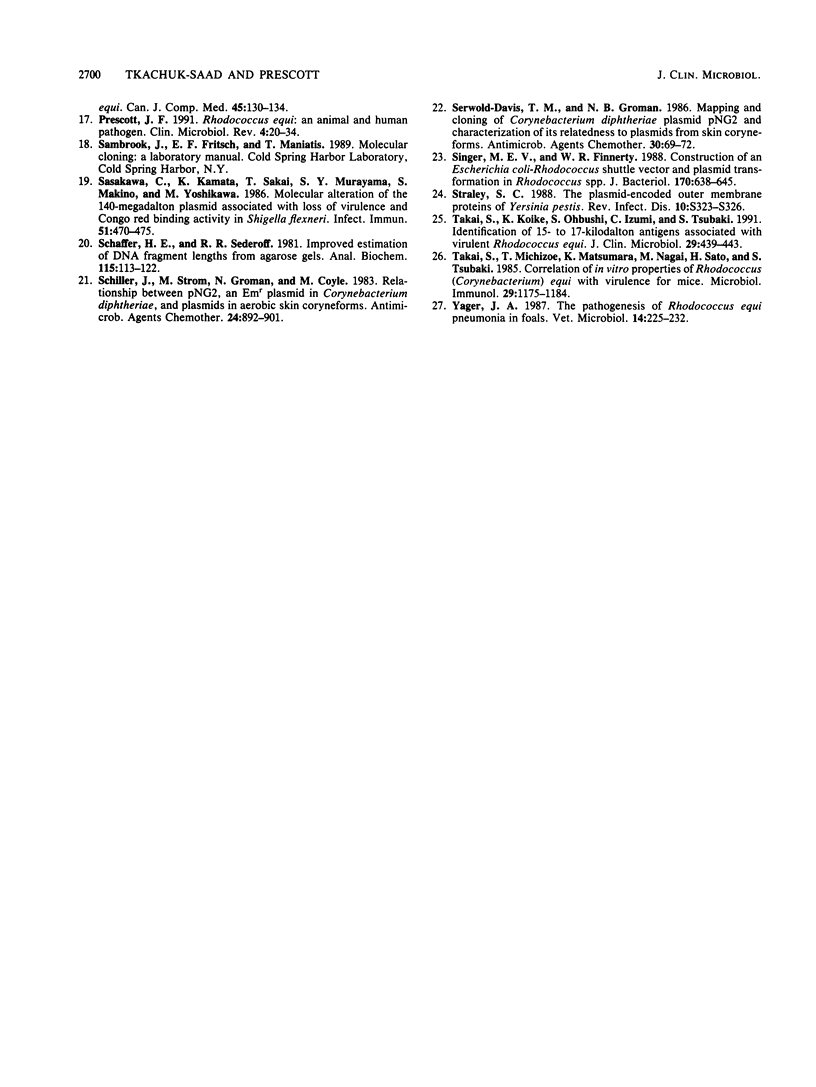Abstract
Fifty-four strains of Rhodococcus equi from different clinical sources (mainly horses and pigs) were examined for their plasmid content by two screening methods. Plasmids were detected in 49 of 54 strains. A plasmid of approximately 80 kb was isolated from 21 of 22 isolates from horses and 20 of 28 isolates from pigs, and a 105-kb plasmid was isolated from 7 of 28 isolates from pigs. The 80-kb plasmid was significantly associated with strains of equine rather than porcine origin, and the 105-kb plasmid was significantly associated with strains of porcine origin. The type strain, ATCC 6939, consistently failed to yield a plasmid. Restriction enzyme analysis of purified plasmid DNA confirmed the relatedness of the 80-kb plasmids isolated from strains of equine and porcine origin. More differences between the restriction patterns of plasmids from strains isolated from horses and from pigs than among strains from either species were observed. Restriction enzyme analysis also showed relatedness of the 105-kb plasmid to the 80-kb plasmid. Three strains shown by others to be virulent in horses or mice possessed the 80-kb plasmid, whereas three other strains not virulent for horses or mice lacked the plasmid, although one had the 105-kb plasmid. There was a significant but not perfect association between the presence of the 80-kb plasmid and production of a diffuse 17.5-kDa thermoregulated, virulence-associated protein. Further study is needed to determine whether this plasmid is associated with virulence in R. equi.
Full text
PDF




Images in this article
Selected References
These references are in PubMed. This may not be the complete list of references from this article.
- Bowles P. M., Woolcock J. B., Mutimer M. D. Experimental infection of mice with Rhodococcus equi: differences in virulence between strains. Vet Microbiol. 1987 Aug;14(3):259–268. doi: 10.1016/0378-1135(87)90113-1. [DOI] [PubMed] [Google Scholar]
- Chirino-Trejo J. M., Prescott J. F. Antibody response of horses to Rhodococcus equi antigens. Can J Vet Res. 1987 Jul;51(3):301–305. [PMC free article] [PubMed] [Google Scholar]
- Dabbs E. R., Sole G. J. Plasmid-borne resistance to arsenate, arsenite, cadmium, and chloramphenicol in a Rhodococcus species. Mol Gen Genet. 1988 Jan;211(1):148–154. doi: 10.1007/BF00338406. [DOI] [PubMed] [Google Scholar]
- Desomer J., Dhaese P., Van Montagu M. Conjugative transfer of cadmium resistance plasmids in Rhodococcus fascians strains. J Bacteriol. 1988 May;170(5):2401–2405. doi: 10.1128/jb.170.5.2401-2405.1988. [DOI] [PMC free article] [PubMed] [Google Scholar]
- Emmons W., Reichwein B., Winslow D. L. Rhodococcus equi infection in the patient with AIDS: literature review and report of an unusual case. Rev Infect Dis. 1991 Jan-Feb;13(1):91–96. doi: 10.1093/clinids/13.1.91. [DOI] [PubMed] [Google Scholar]
- Harvey R. L., Sunstrum J. C. Rhodococcus equi infection in patients with and without human immunodeficiency virus infection. Rev Infect Dis. 1991 Jan-Feb;13(1):139–145. doi: 10.1093/clinids/13.1.139. [DOI] [PubMed] [Google Scholar]
- Martens R. J., Fiske R. A., Renshaw H. W. Experimental subacute foal pneumonia induced by aerosol administration of Corynebacterium equi. Equine Vet J. 1982 Apr;14(2):111–116. doi: 10.1111/j.2042-3306.1982.tb02359.x. [DOI] [PubMed] [Google Scholar]
- Murai N., Skoog F., Doyle M. E., Hanson R. S. Relationships between cytokinin production, presence of plasmids, and fasciation caused by strains of Corynebacterium fascians. Proc Natl Acad Sci U S A. 1980 Jan;77(1):619–623. doi: 10.1073/pnas.77.1.619. [DOI] [PMC free article] [PubMed] [Google Scholar]
- Portnoy D. A., Martinez R. J. Role of a plasmid in the pathogenicity of Yersinia species. Curr Top Microbiol Immunol. 1985;118:29–51. doi: 10.1007/978-3-642-70586-1_3. [DOI] [PubMed] [Google Scholar]
- Prescott J. F. Capsular serotypes of Corynebacterium equi. Can J Comp Med. 1981 Apr;45(2):130–134. [PMC free article] [PubMed] [Google Scholar]
- Prescott J. F. Rhodococcus equi: an animal and human pathogen. Clin Microbiol Rev. 1991 Jan;4(1):20–34. doi: 10.1128/cmr.4.1.20. [DOI] [PMC free article] [PubMed] [Google Scholar]
- Sasakawa C., Kamata K., Sakai T., Murayama S. Y., Makino S., Yoshikawa M. Molecular alteration of the 140-megadalton plasmid associated with loss of virulence and Congo red binding activity in Shigella flexneri. Infect Immun. 1986 Feb;51(2):470–475. doi: 10.1128/iai.51.2.470-475.1986. [DOI] [PMC free article] [PubMed] [Google Scholar]
- Schaffer H. E., Sederoff R. R. Improved estimation of DNA fragment lengths from Agarose gels. Anal Biochem. 1981 Jul 15;115(1):113–122. doi: 10.1016/0003-2697(81)90533-9. [DOI] [PubMed] [Google Scholar]
- Schiller J., Strom M., Groman N., Coyle M. Relationship between pNG2, an Emr plasmid in Corynebacterium diphtheriae, and plasmids in aerobic skin coryneforms. Antimicrob Agents Chemother. 1983 Dec;24(6):892–901. doi: 10.1128/aac.24.6.892. [DOI] [PMC free article] [PubMed] [Google Scholar]
- Serwold-Davis T. M., Groman N. B. Mapping and cloning of Corynebacterium diphtheriae plasmid pNG2 and characterization of its relatedness to plasmids from skin coryneforms. Antimicrob Agents Chemother. 1986 Jul;30(1):69–72. doi: 10.1128/aac.30.1.69. [DOI] [PMC free article] [PubMed] [Google Scholar]
- Singer M. E., Finnerty W. R. Construction of an Escherichia coli-Rhodococcus shuttle vector and plasmid transformation in Rhodococcus spp. J Bacteriol. 1988 Feb;170(2):638–645. doi: 10.1128/jb.170.2.638-645.1988. [DOI] [PMC free article] [PubMed] [Google Scholar]
- Straley S. C. The plasmid-encoded outer-membrane proteins of Yersinia pestis. Rev Infect Dis. 1988 Jul-Aug;10 (Suppl 2):S323–S326. doi: 10.1093/cid/10.supplement_2.s323. [DOI] [PubMed] [Google Scholar]
- Takai S., Koike K., Ohbushi S., Izumi C., Tsubaki S. Identification of 15- to 17-kilodalton antigens associated with virulent Rhodococcus equi. J Clin Microbiol. 1991 Mar;29(3):439–443. doi: 10.1128/jcm.29.3.439-443.1991. [DOI] [PMC free article] [PubMed] [Google Scholar]
- Takai S., Michizoe T., Matsumura K., Nagai M., Sato H., Tsubaki S. Correlation of in vitro properties of Rhodococcus (Corynebacterium) equi with virulence for mice. Microbiol Immunol. 1985;29(12):1175–1184. doi: 10.1111/j.1348-0421.1985.tb00907.x. [DOI] [PubMed] [Google Scholar]
- Yager J. A. The pathogenesis of Rhodococcus equi pneumonia in foals. Vet Microbiol. 1987 Aug;14(3):225–232. doi: 10.1016/0378-1135(87)90109-x. [DOI] [PubMed] [Google Scholar]




